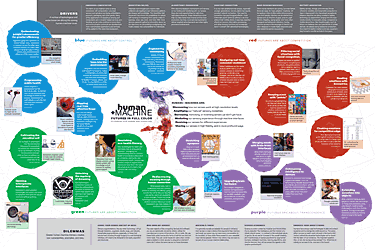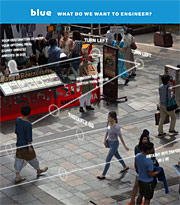Human+Machine Futures Map with Scenarios

Human+Machine Futures in Full Color
Extending our sense and ourselves
The human story is one of using technology to extend our senses and our selves. We invented writing to extend our expressions over space and time. We built a global network of digital portals from which to make, share, and compare the varieties of human experience. Emerging technology is enhancing and accelerating this process and we’re now entering a new stage in the ongoing exploration of vast unknown territories of sensory experience—and human-machine symbiosis.
In 2015, the Technology Horizons program’s research focus is on Human+Machine Futures, the blurring lines between human and machine, natural and artificial.
In June we hosted a conference, The Automated World: Toward Human+Machine Symbiosis, to explore the question, “what happens when technology allows us to automate just about anything?” We debuted our map of the decade of the same name at the conference, and with the help of leading thinkers in the field we worked with attendees to help them understand these emerging technologies’ implications for them and their organizations.
This fall we’re exploring the future of Body Area Networks, asking the question, “What happens when our bodies become the next frontier of technology adoption?” We’ll also be doing a deep dive into how technology is transforming human identity, as well as explore the future of biotech.
 We're excited to share the first publicly-available research project on this theme, Human+Machine Futures in Full Color: Extending Our Senses and Ourselves. It forecasts the ways that emerging technological capacities will remake and remix our sensory experiences, and it explores how we’ll access this technology and what we’ll use it for in the next decade.
We're excited to share the first publicly-available research project on this theme, Human+Machine Futures in Full Color: Extending Our Senses and Ourselves. It forecasts the ways that emerging technological capacities will remake and remix our sensory experiences, and it explores how we’ll access this technology and what we’ll use it for in the next decade.
Over the next decade, advances in technology will create new forms of human-machine symbiosis, expanding and even redefining what we can do with our five senses. This map examines how Humans+Machines are:
- Discovering how our senses work at high-resolution levels.
- Amplifying our “natural” sensory modalities.
- Borrowing, mimicking, or inventing senses we don’t yet have.
- Mediating our sensory experience through machine interfaces.
- Remixing our senses for different experiences.
- Sharing our senses in high fidelity, and in more profound ways.
These technological capacities represent an emerging palette with which to create new products, services, systems, and experiences. How we use this palette will be colored by our beliefs, our priorities, and our values.
Forecasting in Full Color
At IFTF, we use a color mythology system for describing the look and feel of the future, as well as the impulses creating it. This system helps us understand the beliefs, priorities, and values driving innovation and the possible lived experiences of those participating in these futures by giving us new terminology—blue, red, green, and purple—to describe them. The forecasts on this map are arranged by these colors. Each color represents a future possibility, a distinct scenario in our Human+Machine future.
While the future will contain elements of all of these color forecasts, we separated them so you can explore each systematically and identify directions of future change to create the Human+Machine future you want.
 In addition to these forecasts, we created four artifacts from the future for this map—each represents one of the four colors in the system. These artifacts are designed to give you a concrete example of how these emerging tech capacities will be used in each color’s future and what the interface for each could look like.
In addition to these forecasts, we created four artifacts from the future for this map—each represents one of the four colors in the system. These artifacts are designed to give you a concrete example of how these emerging tech capacities will be used in each color’s future and what the interface for each could look like.
Together, these colors and artifacts are intended to help your organization think through its strategic vision, playing out how certain elements of the human and machine future may impact you over the next ten years and beyond.
Principally, we break each of these elements into four provocations:
- What will you need to discover?
- What will you need to engineer?
- What will you need to grow?
- What will you need to win?
To thrive in the human and machine world, we’ll have to think through how to best leverage these new tools and capabilities.
Publication Date
2015
To learn more ...
- Learn about becoming a Future 50 Partner
- Contact Sean Ness | 650-233-9517 | [email protected]




